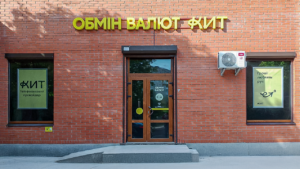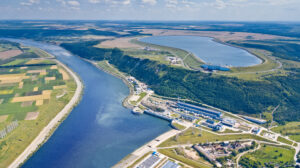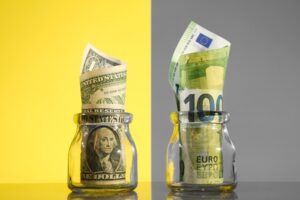
KYT Group, one of the leaders in the currency exchange and financial services market in Ukraine, continues its strategic expansion of its network in regions with high economic activity.
On April 29, 2025, the company’s first branch opened in the city of Bila Tserkva, Kyiv region. Thus, KYT Group’s modern services now cover 30 cities in Ukraine, and the total number of exchange points in the network with national coverage has reached 96 branches.
The new currency exchange point of the KYT Group network is located at 1 Hryhoriya Kovbasyuka Street, Bila Tserkva, Kyiv region. It is conveniently located in the city center, close to popular shopping centers and supermarkets, allowing customers to easily combine a visit to a financial service with other daily activities.
The branch will be open every day from 9:00 a.m. to 6:00 p.m., offering the group’s high standards of service, favorable currency exchange rates, and a personalized approach to customer requests.
Detailed information about the work of this and other branches of the network and the terms and conditions of operations, as well as consultations, can be obtained from the KYT Group customer support center at 0 800 331957.
The opening of the branch in Bila Tserkva is another step in KYT Group’s strategy to strengthen its presence in key cities of Ukraine to meet the demand among Ukrainians for high-quality modern financial services.
The geographical expansion of KYT Group’s presence aims to provide Ukrainians with even broader access to services that meet the highest industry standards.
The new branch in Bila Tserkva has been designed in line with the brand’s updated identity. This is part of KYT Group’s large-scale rebranding, which emphasizes its position as an innovative leader in the non-bank financial services market. The branch in Bila Tserkva offers customers all the key advantages of a national leader in currency exchange:
Ø Online currency exchange rate fixing for 60 minutes via the official website, Telegram channel, or customer support service — a unique solution for the Ukrainian market that allows you to plan your exchange in advance on the most favorable terms, even in conditions of exchange rate volatility.
Ø Special conditions for wholesale currency exchange — convenient for customers with large transaction volumes who want to get the best deal.
During 2024–2025, the KYТ Group network is actively expanding. Its new branches have already been opened in Chernivtsi, Ivano-Frankivsk, Odesa, Kamyanske, Uman, Chernihiv, Kryvyi Rih, and now in Bila Tserkva.
KYT Group continues to invest in network expansion and service improvement, digital infrastructure, and customer experience, remaining a reliable partner for Ukrainians in the field of currency transactions.
ABOUT
KYT Group is an international multi-service FinTech company whose flagship business is currency exchange. KYT Group is one of the largest operators in this segment of the financial market. According to data from the National Bank of Ukraine, it ranks first in the industry rating in terms of taxes paid, capital size, and business success based on financial results. The KYT Group network of 96 exchange points covers 30 of Ukraine’s largest cities. The company’s activities comply with the regulatory requirements of the NBU.
The KYT Group’s long-standing efforts to achieve leadership positions, improve services, customer and IT infrastructure have been recognized by the prestigious Banker Awards 2024 in the category “Reliable Technology Partner for Exchange Transactions,” as well as the award “Financial Market Leader” among non-bank financial institutions according to “TOP-100. Ratings of the largest.”

According to SERBIAN ECONOMIST, on April 24, 2025, Albania reintroduced visa-free travel for Belarusian citizens, allowing them to stay in the country for up to 30 days. This decision cancels the previously introduced visa restrictions and makes Albania accessible again to Belarusian tourists without the need to obtain a visa.
Main conditions for visa-free entry
Validity: the visa-free regime is valid until September 30, 2025.
Maximum length of stay: up to 30 days from the date of entry.
Purpose of travel: tourism and short-term private visits.
Documents: you must have a valid passport that is valid for at least 3 months after the date of departure from Albania.
Earlier, in April 2025, Albania suspended the visa-free regime for Belarusian citizens, requiring them to obtain a visa for entry. However, in light of the current changes, Belarusian citizens can once again visit Albania without a visa, which contributes to the development of tourist and cultural ties between the two countries.
Belgrade. May 5. SERBIAN ECONOMIST

Enefit Industry AS, a subsidiary of the Estonian state-owned energy company Eesti Energia, has announced a tender for the construction of a 100 MW gas-fired combined cycle power plant as part of the Baltic Power Plant complex in Narva. According to Enefit Industry, it intends to use this power plant in the reserve capacity market to balance the power grid.
The company plans to sign a turnkey contract for the construction of the facility. The value of the state contract is estimated at €100 million, and construction is scheduled for completion in 2028.
“The power plant is designed to generate heat and electricity in cogeneration mode and to provide reserve capacity (….) It will operate on gas piston engine technology with a capacity of 4 to 13 MW. It is expected that the plant will run mainly on natural gas or biomethane and should already be capable of using up to 25% hydrogen as fuel,” the statement said.
It is noted that during the gas station’s operating hours, residual heat can be supplied to the Narva heating network.
“The situation on both the frequency markets and the day-ahead electricity market clearly shows that Estonia needs new flexible and dispatchable generation capacity. The advantage of an autonomous gas-fired power plant is its quick start-up, which helps to respond quickly when electricity prices are high,” said Enefit Industry CEO Lauri Karp, quoted in the report.
The preliminary qualification stage of the tender will last until May 29, and Enefit Industry expects to receive preliminary applications by the end of June.
The company emphasizes that the tender is a prerequisite for participation in the procurement of frequency reserve announced by the data transmission system operator Elering.
As reported, the Estonian energy company Eesti Energia has reorganized and spun off its shale extraction, processing, and liquid fuel production businesses into a separate entity, Enefit Industry AS.
“From April 1, the power plants will continue to operate as Enefit Power OU, while the liquid fuel production plants and extraction divisions will operate as Enefit Industry AS,” Eesti Energia said.
All shale-fired thermal power plants within the group perform a reserve function.

PJSC Novokramatorsk Machine-Building Plant (NKMZ, Kramatorsk, Donetsk region) will pay dividends to shareholders totaling UAH 223.314 million in the period from May 29 to November 1 this year at the rate of UAH 1 thousand per share (par value UAH 400).
According to a publication in the NSSMC’s information disclosure system, the decision to pay dividends was made by the company’s general shareholders’ meeting on April 28, and the supervisory board on May 5.
According to the NSSMC, as of the fourth quarter of 2024, the company’s president, Georgiy Skudar, owns more than 8.97% of NKMZ shares, while Galina Savenko and Elena Yakovleva, respectively, own almost 33.586% and 33.63% (according to media reports, Skudar’s daughters – IF-U). Since December 2023, the Supervisory Board of NKMZ has been chaired by the company’s Vice President Dmytro Skudar.
As reported, the shareholders allocated the entire net profit of UAH 36.33 million received in 2024, as well as part of the previously unused profit in the amount of UAH 186.98 million, to pay dividends.
According to the company, retained earnings as of the beginning of this year exceeded UAH 2.34 billion.
According to the company, NKMZ’s net income in 2024 increased by 3.2 times year-on-year to UAH 1 billion 146 million, including exports to Europe and Asia worth UAH 941.3 million (82%).
In 2024, Slovakia, Lithuania, Egypt and Luxembourg were added to the list of NKMZ’s largest importing countries along with Uzbekistan, Kazakhstan (where exports decreased 12.3 times over the year) and India (where exports increased 31 times). Deliveries in Ukraine increased 5.2 times to UAH 204.6 million.
In 2023, the plant suffered a loss of UAH 856.93 million.
As reported, NKMZ, whose facilities were forced to be mothballed with the start of Russia’s full-scale military invasion of Ukraine, began to partially resume operations on October 1, 2023.
Last year, the workers were forced to stand idle from January 29 to March 1 “due to irregular production and economic activities, lack of centralized heating of production units and saving of fuel and energy resources.”
NKMZ is a city-forming enterprise in Kramatorsk and the largest in Ukraine for the production of rolling, metallurgical, forging and pressing, hydraulic, mining, lifting and transport, hydraulic and railway equipment.
As of the beginning of 2023, the average number of its employees exceeded 7.2 thousand, and as of the beginning of 2025, it was 5.660 thousand.

The National Bank of Ukraine (NBU), in the absence of currency purchases, increased its sales on the interbank market last week by $123.8 million, or 20.0%, to $742.70 million, according to statistics from the regulator on its website. The data published by the regulator during this period indicate a change in the cash currency market: while on Monday sales exceeded purchases by $6.4 million, on Tuesday purchases exceeded sales by $6.8 million, and on Thursday there was a negative balance of $40.6 million.
‘Household activity in the cash market has been declining for the third month in a row: average daily demand fell from $41 million in February to $17 million in April. This indicates a decrease in panic sentiment, market saturation and/or the exhaustion of the population’s purchasing power against the backdrop of weak economic growth. Another factor could be the spring holiday cycle, which is a traditional period for selling foreign currency savings to celebrate and finance short-term vacations,’ commented KYT Group on the situation in the cash market.
The official hryvnia exchange rate strengthened in the first half of the week from 41.75 UAH/USD to 41.4706 UAH/USD, but weakened again to 41.7091 UAH/USD by the end of the week. Despite the increase in the negative balance, the exchange rate on the cash market did not change significantly, and over the weekend, the dollar even fell by 5 kopecks. The purchase rate fell to 41.40 UAH/$1, and the sale rate fell to 41.50 UAH/$1.
According to KYT Group experts, the dollar exchange rate will remain within a narrow range.
‘Short-term outlook (2-4 weeks): the most likely movement is towards 41.20-41.80 UAH/USD with minor deviations (±20-30 kopecks). Volatility is low, speculative demand is limited. Medium term (2-4 months): a correction to 42.00-42.50 UAH/$1 is possible in the event of increased imports, accelerated inflation or a weakening of external financing,’ the company predicts.
Source: https://interfax.com.ua/news/projects/1067965.html

Following the first round of the presidential elections in Romania, held on May 4, 2025, two candidates with opposing political views advanced to the second round: far-right nationalist George Simion and pro-European Nicușor Dăn.
According to data from Romania’s Central Election Bureau, after almost all ballots were counted:
George Simion, leader of the Alliance for the Unity of Romanians (AUR) party, received 40.96% of the vote (3,862,404 voters).
Nicușor Dăn, an independent candidate and mayor of Bucharest, received 20.99% of the vote (1,979,711 voters).
The candidate from the ruling PSD-PNL-UDMR coalition, Crin Antonescu, lost to Dan towards the end of the vote count and did not make it to the second round.
The second round of elections is scheduled for May 18, 2025.
Political views of the candidates
Djordje Simion
Leader of the far-right AUR party, Simion is known for his nationalist and Eurosceptic rhetoric. His main positions include:
Latest news & breaking headlines
Skepticism toward the EU and NATO: Criticizes EU leadership and opposes greater integration.
Opposition to military aid to Ukraine: Believes that Romania should not provide military aid to Ukraine.
Support for the idea of a Greater Romania: Advocates restoring Romania’s pre-World War II borders, including territories in Moldova and Ukraine.
Proximity to Donald Trump’s ideology: expresses support for the former US president and his policies.
Simeon has also stated his intention to include Calin Georgescu, who was previously barred from participating in the elections due to allegations of pro-Russian ties, in his government.
Nicușor Dăn
The current mayor of Bucharest, Dan positions himself as a pro-European reformer. His key positions:
Support for Romania’s membership in the EU and NATO: advocates strengthening ties with Western allies.
Fighting corruption: emphasizes the need for reforms and transparency in public administration.
Improving urban infrastructure: as mayor, he has focused on developing the urban environment and improving the quality of life for citizens.
Impact on domestic and foreign policy
The election results could significantly influence Romania’s course:
If Simion wins:
A shift away from the pro-European course and a strengthening of nationalist policies are possible.
Potential deterioration of relations with the EU and neighboring countries, especially in the context of territorial claims.
If Dan wins:
Maintaining and strengthening ties with the EU and NATO.